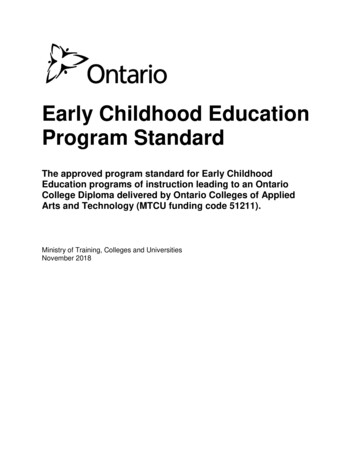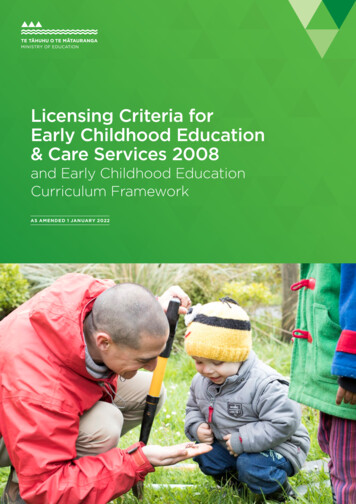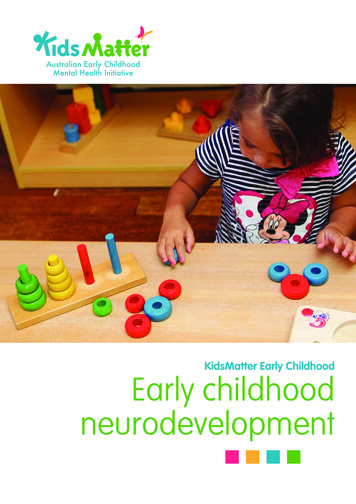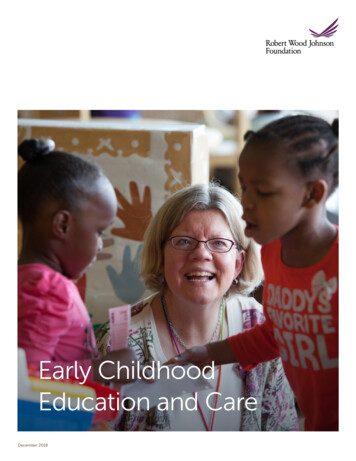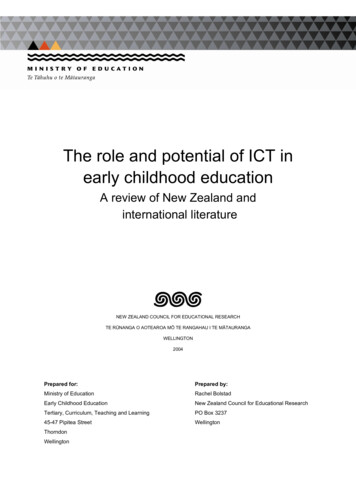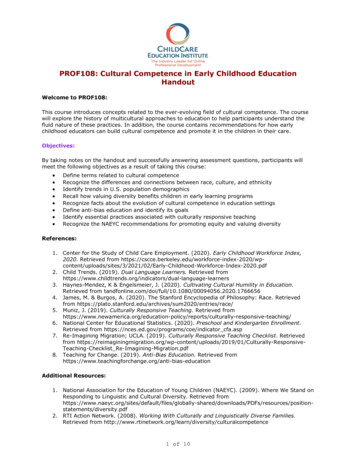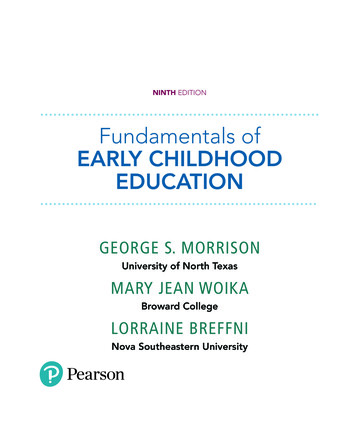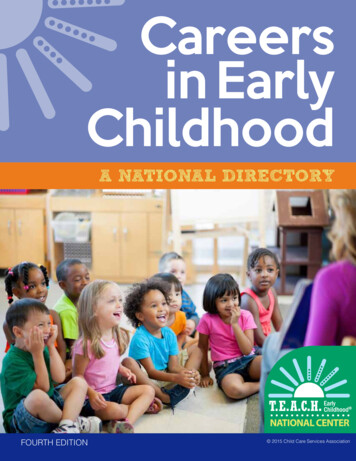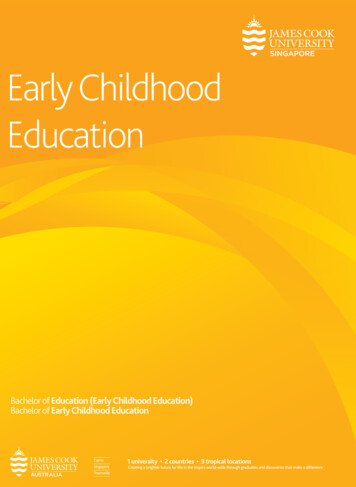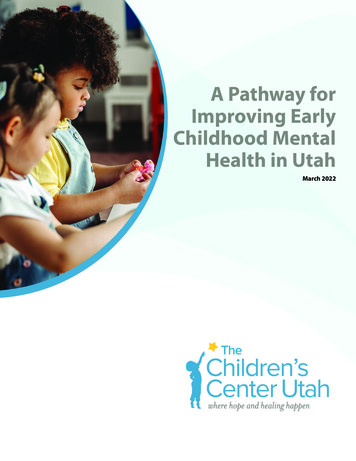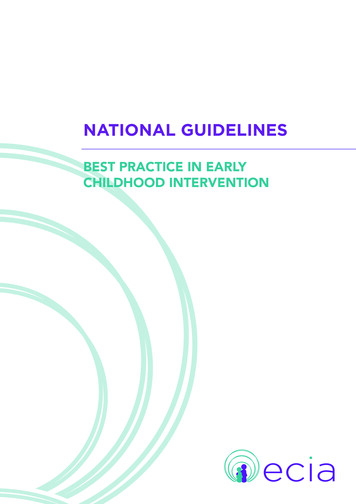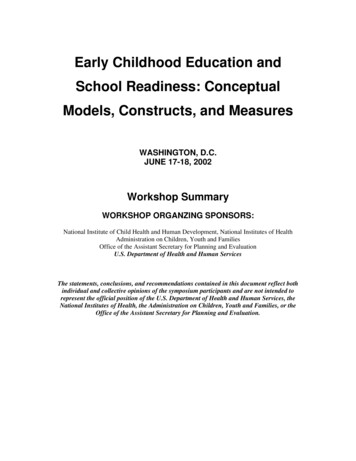
Transcription
Early Childhood Education andSchool Readiness: ConceptualModels, Constructs, and MeasuresWASHINGTON, D.C.JUNE 17-18, 2002Workshop SummaryWORKSHOP ORGANZING SPONSORS:National Institute of Child Health and Human Development, National Institutes of HealthAdministration on Children, Youth and FamiliesOffice of the Assistant Secretary for Planning and EvaluationU.S. Department of Health and Human ServicesThe statements, conclusions, and recommendations contained in this document reflect bothindividual and collective opinions of the symposium participants and are not intended torepresent the official position of the U.S. Department of Health and Human Services, theNational Institutes of Health, the Administration on Children, Youth and Families, or theOffice of the Assistant Secretary for Planning and Evaluation.
Early Childhood Education and School Readiness Workshop, June 17-18, 2002TABLE OF CONTENTSI.INTRODUCTION. 1II.PART ONE: CURRENT STATE OF KNOWLEDGE AND PRIORITIES FORINSTRUMENT DEVELOPMENT . 3A.OVERVIEW. 3B.CONTEXT AND BACKGROUND. 4C. GENERAL SUGGESTIONS FOR MEASUREMENT, INSTRUMENT DEVELOPMENTAND RESEARCH. 7Achieve Breadth and Depth . 8Ground Instruments in Theory and Developmental Data. 9Use Measures Appropriate for the Population . 10Include Direct Child Assessments with Parent and Teacher Report . 11Use and Develop Measures with Sound Psychometric Properties . 11Establish and Follow Guidelines for Training and Administration. 12Control for Type I and Type II Errors and Repeated Testing Effects . 12Develop Efficient and Integrative Systems of Assessment . 12D. SUGGESTIONS FOR INSTRUMENT DEVELOPMENT AND RESEARCH IN CONTENTDOMAINS . 13Language and Early Literacy . 13Mathematics. 14Social-Emotional Development. 15Regulation of Attention, Behavior, and Emotion . 16E.RECOMMENDATIONS FOR INSTRUMENTS . 17Language Measures . 17Literacy Measures. 20Mathematics Measures . 23General Cognition Measures . 25Social-Emotional Development Measures . 25Regulation of Attention, Behavior, and Emotion Measures. 27PART TWO: DESIGNING A NATIONAL REPORTING SYSTEM FOR HEAD START. 31A.Federal Reporting Systems Currently Underway. 31B.Design Options . 32C.Outcome Areas . 33D.Measures . 34E.Professional Development . 36F.Conceptual Models and Components. 37Page i
Early Childhood Education and School Readiness Workshop, June 17-18, 2002G. Priorities for Research and Measurement Development . 38IV.REFERENCES. 39APPENDIX A: Participants. 43APPENDIX B: Language Milestones and Associated Constructs and Measures . 47Page ii
Early Childhood Education and School Readiness Workshop, June 17-18, 2002Early Childhood Education and School Readiness Workshop:Conceptual Models, Constructs, and MeasuresI.INTRODUCTIONOn June 17-18, 2002, a multidisciplinary group of experts was convened to advise the National Instituteof Child Health and Human Development (NICHD), the Administration on Children, Youth and Families(ACYF), and the Office of the Assistant Secretary for Planning and Evaluation (ASPE) within the U.S.Department of Health and Human Services (DHHS) on the measurement and assessment of learning anddevelopment in early childhood, and on priorities for measures development. Participants includedexperts in early language, literacy, and mathematics; cognitive, social, and emotional development;regulation of attention, behavior, and emotion; early school achievement and transition; special education;reading disabilities; developmental cognitive neuroscience; research design and quantitative methods inintervention, longitudinal and observational research; and early childhood policy, practice, andprofessional development (see Appendix A for list of participants).This meeting was the first in a series to inform a set of research and programmatic initiatives funded bythe DHHS and the U.S. Department of Education. The intent of the initiatives is to stimulate research andapply scientific knowledge to ensure that all children, from birth through age five, develop the earlyknowledge, skills, and competencies needed to benefit from high-quality instruction in kindergarten andthe early grades. Specifically, an Interagency Early Childhood Research Initiative funded by the DHHSand Department of Education has been announced to encourage research that answers the overarchingquestion: Which early childhood programs or combinations of program components and interactions withadults and peers are effective or ineffective in promoting early learning and development, for whichchildren, and under which conditions? The results will be used to inform early childhood programs andpractices in pre-kindergarten, home-based and center-based child care, family childcare, and Head Start.In addition, the President’s early childhood initiative, Good Start, Grow Smart, charges the Head StartBureau under the ACYF with designing a national reporting system to monitor the progress of every childin Head Start in the legislatively mandated areas of language, literacy, and early numeracy. The data willbe used for program improvement and accountability. Piloting of assessments was scheduled for fall2002 with full implementation set for fall 2003. This meeting also informed that effort.Workshop presenters and participants were asked to consider current research on what children shouldlearn and develop from birth through age five to prepare for kindergarten and the early grades. For bothresearch and programmatic purposes, they were asked the questions: What constructs should bemeasured? What are the strengths and weaknesses of available instruments? What approaches should betaken in developing a set of instruments with adequate coverage? What are the priorities for instrumentdevelopment and research to support the development of new measurement and assessment tools?Individual working groups focused first on constructs and measures within specific domains ofdevelopment (i.e., language and literacy; cognition and mathematics; regulation of attention, behavior,emotion; social-emotional competency). Next, multidisciplinary groups recommended strategies fordeveloping measurement packages that assess children’s progress across all domains, and outlinedpriorities for future instrument development and research. Part One of this document summarizes thesepresentations and discussions.Page 1
Early Childhood Education and School Readiness Workshop, June 17-18, 2002Part Two describes sessions that focused specifically on Head Start’s national reporting system.Discussions laid groundwork for a July 9, 2002, meeting that was sponsored by the ACYF incollaboration with the NICHD to finalize assessment and design options. Though the focus was on HeadStart, the ideas generated were valuable for informing any systematic attempt to design, implement,evaluate, and report on the effectiveness of large-scale, comprehensive, early childhood educationprograms. In addition, discussions revealed gaps in available and widely used measurement andassessment tools, and in basic knowledge of learning and development that limit the potential of such asystem for program evaluation and improvement. These gaps present clear challenges to researchcommunities across disciplines. Thus, Part Two contains additional priorities that emerged in discussionsfor developing new measures and generating the knowledge needed to design systems that would be mostuseful for evaluating and promoting children’s progress.This summary report is being disseminated to share the content of workshop discussions. The report isnot intended to provide a comprehensive review of the relevant scientific knowledge base, an exhaustiveinventory of measures, or complete descriptions of the measures that were discussed. Citations areprovided for additional information, where possible. The report is also not intended to be an endorsementof particular approaches to measurement. The constructs, measures and priorities for measurementdevelopment included reflect the specific interests and expertise of the workshop participants. The eventwas not a consensus conference, however; and thus the content should not be interpreted as representingthe views of each participant. Presentations and discussions were recorded, synthesized into a draftreport, and participants were given the opportunity to review the draft and correct factual errors. The cosponsors of this event thank the participants for the time and effort they devoted to discussions and toreviewing and editing these proceedings.Page 2
Early Childhood Education and School Readiness Workshop, June 17-18, 2002II.PART ONE: CURRENT STATE OF KNOWLEDGE AND PRIORITIES FORINSTRUMENT DEVELOPMENTA.OVERVIEWTo provide context and background, presentations by experts in early childhood research, practice, andpolicy described a set of current approaches to measuring early learning and development in studies ofearly childhood interventions, large-scale nationally representative surveys of school readiness, impactresearch on Head Start and Early Head Start, descriptive child care research, classroom-basedobservational assessments of children’s progress, and a 50-state study of early childhood programstandards and assessment systems. Presenters explained measurement strategies, discussed strengths andweaknesses of existing tools, highlighted new tools under development, and suggested areas where newmeasures are urgently needed. Each presentation was followed by a period of open discussion.Several general recommendations emerged from presentations and group discussions, motivated bystrengths and weaknesses of approaches to measurement that experts observed in the field: Ground instruments in child development theory and dataDevelop measures that have practical relevanceUse measures appropriate for the population (e.g., norms and psychometrics should beappropriate to the language, culture, age-span of the group studied; clinical measures are not idealfor studying typical development)Include direct child assessments with parent and teacher reportUse and develop measures with sound psychometric properties (while avoiding ad-hoc, atheoretical construction)Establishing and following guidelines for training and administrationControlling for type I and type II errors and repeated testing effectsDeveloping efficient and integrated systems of assessment that provide robust measures across allareas of learning and development and that are based on the most recent and rigorous scientificfindingsIn group discussions, participants recommended that measurement strategies for research be designed toachieve breadth and depth, including both a broad sampling of items across content domains as well as aset of in-depth measures that comprehensively assess constructs within each domain of interest and thatare tailored to the intervention. Participants suggested constructs that should be covered in specific areasof language, literacy, early mathematics, social and emotional development, and regulation of attention,behavior, and emotion, and directions for research and instrument development in each content domain.Researchers discussed the strengths and weaknesses of existing instruments. Of particular interest weremeasures that could be used or developed as core instruments and that would allow the combining of dataacross studies to answer larger sets of research questions, comparing of results, and conduct of metaanalyses. As the instruments were discussed, researchers categorized them into one of three tiersaccording to whether or not they are well-standardized, promising experimental measures, or appropriatefor use in large-scale research relating to early childhood interventions or programs. A few measures thatenjoy popularity were not recommended for continued use, especially in studies of early childhoodintervention.Page 3
Early Childhood Education and School Readiness Workshop, June 17-18, 2002B.CONTEXT AND BACKGROUNDPresenters with expertise in research, practice, and policy outlined goals and criteria for selectingmeasures, strengths and weaknesses of existing instruments, challenges of assessing and reporting onchildren’s progress, and suggestions for developing new measures and assessment systems. Themes thatemerged across presentations and working groups are summarized together in the next section, GeneralSuggestions for Measurement, Instrument Developmen,t and Research.Susan Landry, University of Texas-Houston, Health Sciences CenterDr. Landry presented approaches to measurement used in research to implement and evaluate the effect ofa model professional development program for Head Start teachers. Designed by researchers andeducational training staff from the Center for Improving the Readiness of Children for Learning andEducation (CIRCLE), the model is based on research supported with over 15 years of federal, state, andprivate funding on factors most important for supporting young children's cognitive and socialdevelopment. The program promotes social and emotional growth while focusing on three key programcomponents critical to later reading and academic success: 1) language development, 2) early literacy(i.e., phonological awareness, letter knowledge, written expression, book and print awareness, motivationto read), and 3) early mathematics (e.g., number and operations).JoAnn Robinson, University of Colorado, Health Sciences CenterDr. Robinson described theoretically motivated approaches to selecting constructs and measures for threerecent intervention studies: Home Visitation 2000; Memphis New Mothers Study; and Early HeadStart-Denver. The interventions span the period from birth through age seven. The studies weredesigned to test the hypothesis that inadequate prenatal care and dysfunctional styles of parent-childinteraction impair neurobiological growth and negatively affect emotion and behavior regulation, as wellas cognitive and executive functions, resulting in poor academic performance and antisocial behavior.Thus, interventions that ensure adequate prenatal care and more functional parent-child interactions arepredicted to provide children with early experiences needed to benefit later from strategies intended topromote early literacy, language, and cognitive development.John Love, Mathematica Policy Research, Inc.Dr. Love described the Early Head Start Research and Evaluation project in which families wererandomly assigned to Early Head Start or to a control group. The project includes outcome measures forinfants and toddlers from 3,000 low-income families living in 17 diverse communities in the UnitedStates (http://www.acf.dhhs.gov/programs/core/ongoing research/ehs/ehs intro.html).Dr. Love emphasized that though measures in all areas need development, better specification ofconstructs and instruments are especially needed to assess approaches to learning (task persistence,curiosity, initiative, planfulness); social and emotional development; language development (to assessmore than receptive vocabulary); and motor development.Dr. Love proposed that a system of measurement be developed to meet the challenge of comprehensivelymeasuring the effectiveness of early childhood programs that would be feasible for use in large-scaleresearch and that would assess children’s progress across time. The system would include a collection ofstandard measures that minimize time, cost, and training, contain optimally balanced content and methods(direct standard assessments and report measures), and a standard administration order. A function of thesystem would be to assess sets of outcomes that correspond to goals that should be the focus of earlyPage 4
Early Childhood Education and School Readiness Workshop, June 17-18, 2002childhood programs regardless of setting (preschool and Head Start classrooms, center- or home-basedchild care programs, and family child care). Data on environmental factors that support or impedeprogress would be essential for interpreting the results and making judgments about how best to allocateresources to improve programs. Knowledge of multiple normative developmental trajectories, less typicaltrajectories not predictive of risk, and trajectories indicating risk for poor outcomes, would beincorporated into the system and be used to evaluate progress. Though parts of such a system could bedesigned using the existing scientific evidence-base, more complex, multi-level, longitudinal data ondiverse populations of children are needed to meet the challenge of developing a system with all of thesecharacteristics.Nicholas Zill and Ronna Cook, Westat Inc.Dr. Zill presented an overview of the Head Start Family and Child Experiences Survey (FACES), alongitudinal study of program performance that compares child outcomes to national g research/faces/faces intro.html). Data collection in thesecond cohort begins in fall 2002 with a sample of 2,800 children entering 43 Head Start programs. Amulti-method approach to measurement includes direct assessment, observation, parent and teacherreports, and behavior ratings. Direct assessments are obtained at the beginning and end of the Head Startyear and at the end of kindergarten. Those administering assessments receive one week of training withquality control follow-up. For the assessment battery, subscales or items were selected from standardnormed measures and unnormed assessments created to cover social, emotional and languagedevelopment, early literacy, cognitive development and general knowledge, motor development andphysical well-being, and approaches to learning. (For a list of measures, seehttp://www.acf.hhs.gov/programs/core/ongoing research/faces/faces2000 instruments/face2000 intro.html).Ms. Cook presented proposed measures for the National Head Start Impact Study, which begins in fall2002 (http://www.acf.dhhs.gov/programs/core/ongoing research/hs/impact intro.html). The studyinvolves 75 grantees, and 5,000 to 6,000 children who will be randomly assigned to Head Start or to acontrol group. The current proposal is to build upon the FACES battery, retaining or adapting measuresthat previously showed improved performance. Goals for improving assessments are to strengthen theoral language assessment of the battery, select more measures that assess growth over time, and ensuretrained field interviewers can administer the measures with acceptable reliability. Criteria for selectingmeasures included: absence of major floor or ceiling effects with Head Start populations, measures thatpredict school achievement, appropriate length to maintain interest and performance levels, andavailability of parallel tests in Spanish and English, at least for a subset of the battery.Jerry West, National Center for Education Statistics, U.S. Department of EducationDr. West provided an overview of the Early Childhood Longitudinal Study-Birth Cohort (ECLS-B)that follows children born in 2001 from birth through the end of kindergarten, and the Early ChildhoodLongitudinal Study-Kindergarten Cohort (ECLS-K) that follows children from kindergarten entrythrough the end of the fifth grade year (http://www.nces.ed.gov/ecls/). The goal of these longitudinalstudies is to report how well public schools, early childhood programs, and other environments in thiscountry prepare children for school and otherwise affect their lives. A specific goal for the birth cohort isto assess factors that are believed to be precursors of later development and scholastic success, and thatlink conceptually to the battery used to assess children’s progress in the kindergarten and first grade. Thelack of national standards for the knowledge and skills children are expected to develop in kindergartenand elementary school complicated selecting constructs and instruments to track children’s progress fromPage 5
Early Childhood Education and School Readiness Workshop, June 17-18, 2002birth through age five with respect to school readiness. Research on child development and schoolachievement led to the selection of constructs in the areas of physical development (e.g., height, weight,middle upper-arm circumference) motor skill, language, literacy, mathematics, general knowledge,prosocial and problem behavior, emotion-regulation, self-control, and approaches to learning. Moststandard measures were inappropriate because of inadequate coverage or developmental range resulting inthe adaptation and development of new measures.Dr. West emphasized the urgent need to develop measures to assess progress across the period of earlychildhood that, when combined, have sufficient breadth and depth of coverage across multiple domainsand yet remain feasible in terms of time, cost, training, and implementation on a large-scale. Studies thatseek nationally representative samples require instruments that are appropriate for assessing all children.Though instruments in most areas need development, direct assessments of social development and socialskills are among the most limited.Margaret Burchinal, University of North Carolina-Chapel HillDr. Burchinal presented measures used in the NICHD Study of Early Child Care and YouthDevelopment (http://www.nichd.nih.gov/od/secc/index.htm). Since 1991, a diverse sample of 1,300families from 10 sites throughout the country has been followed in the study to determine the relationbetween children's early experiences and developmental outcomes. Dr. Burchinal presented dataanalyzed for this meeting on associations between cognitive, language, and social-emotional measurescollected during early childhood and later measures of reading achievement and social skill in first grade.For the period of birth through three, measures included the Bayley Mental Development Index; theMacArthur Child Development Index (CDI); the Achenbach Child Behavior Checklist (CBCL); theAdaptive Social Behavior Inventory (ASBI); the Bracken School Readiness; and the Reynell AuditoryComprehension and Expressive Language Scales. In first grade, children received the WoodcockJohnson Academic Composite and selected subtests (i.e., letter identification, applied problems,incomplete words and memory for sentences); and the Preschool Auditory Comprehension andExpressive Language Scales.Sharon Lynn Kagan, Teachers College, Columbia UniversityDr. Kagan, in collaboration with Dr. Catherine Scott-Little, is undertaking an analysis of standards forearly childhood programs and assessment systems used in the 50 states. The impetus for setting standardsand assessments differs across states and may originate with governors, state legislators or members ofthe early childhood community. Preliminary data show that 28 states have standards of learning anddevelopment. Though many states fund pre-kindergarten programs, no state has a state-wide strategy forassessing all children and few states have standards that align with the assessment system. Approachestaken by South Carolina, North Carolina, and Michigan were described to illustrate differences inpurpose, design, standards, and instrumentation. A nomenclature problem must be remedied, whichmeans that targets of measurement (constructs) must be defined and relations among them described.This knowledge must be incorporated into early childhood systems in the form of frameworks andbenchmarks that align with the content of assessments used to guide classroom practices and evaluateprogram effectiveness.General parameters must be set for designing assessments and reporting systems. Ideally, standards forprograms serving four-year-olds would be aligned with standards for kindergarten, which in turn wouldbe aligned with first-grade. Technical requirements for measures differ according to the purpose ofPage 6
Early Childhood Education and School Readiness Workshop, June 17-18, 2002assessment. A recommendation was that all instruments and systems should be useful for programimprovement. The purposes of the Head Start national reporting system are to improve quality ofinstruction in Head Start classrooms, and to monitor trends for program evaluation and accountability.Any system designed to assess children for reporting at the federal level must consider how it would bealigned with systems at the state level, which differ in design and purpose within states.Next steps for Head Start and other early childhood systems throughout the nation include: a) ensuring theappropriate selection of assessments depending on the purpose; b) generating better information on cost,implementation, training and other supports needed to collect reliable and valid information and to use iteffectively to improve programs; and c) piloting existing instruments and developing new instrumentsbecause most research measures do not meet these practical needs.Sarah Brainerd, Stamford Connecticut and Sharon Lynn Kagan, Teachers College, ColumbiaUniversityMs. Brainerd directs two Head Start programs, one center-based and one mixed center- and home-based,that are participating in a researcher-practitioner partnership with Columbia University. Goals for the2001-2002 academic year were to utilize the Program Review Instrument for Systems Monitoring(PRISM), a national assessment tool for reporting on Head Start programs (see Part Two of thisdocument), and meet legislatively mandated outcomes for Head Start. Challenges have includedidentifying measures for assessing children’s progress that teachers can use to develop the curriculum andto support children’s development, identifying measures appropriate for the Spanish-speaking andbilingual children and staff, and supporting parents in their abilities to promote children’s progress. Theprogram is currently piloting a portfolio-based, work sampling system in two classrooms. Trained staffwill help individual classrooms use the assessments and review data on program strengths and areas forimprovement.Gayle Cunningham, Head Start, Birmingham, Alabama and Martha Abbott-Shim, Georgia StateUniversityMs. Cunningham oversees Head Start and Early Head Start programs with 21 locations in public schools,and a budget that allows only for hiring paraprofessionals. Ms. Cunningham described challenges inreviewing Head Start Performance Standards and selecting tools appropriate for assessing children’sprogress, with a priority on measuring the 13 legislatively mandated outcomes in literacy, language, andnumeracy. The Chicago Early Learning Tool was among a variety of tools that were examined andrejected for inade
early childhood interventions, large-scale nationally representative surveys of school readiness, impact research on Head Start and Early Head Start, descriptive child care research, classroom-based observational assessments of children's progress, and a 50-state study of early childhood program standards and assessment systems.
